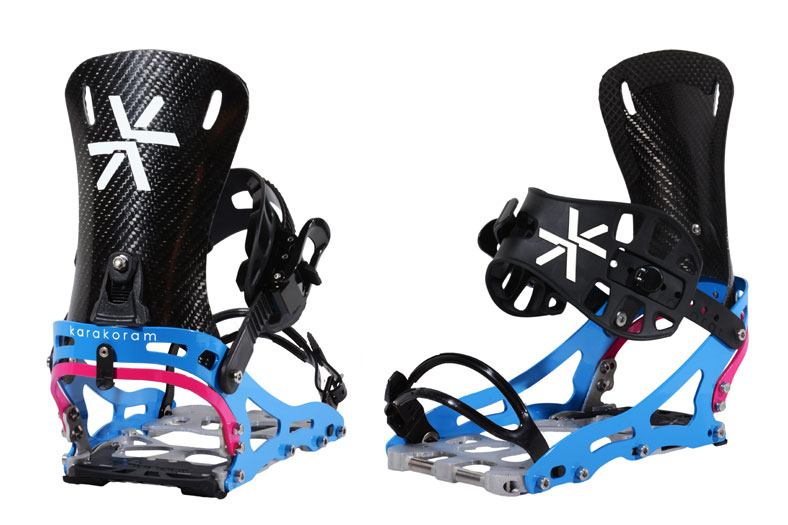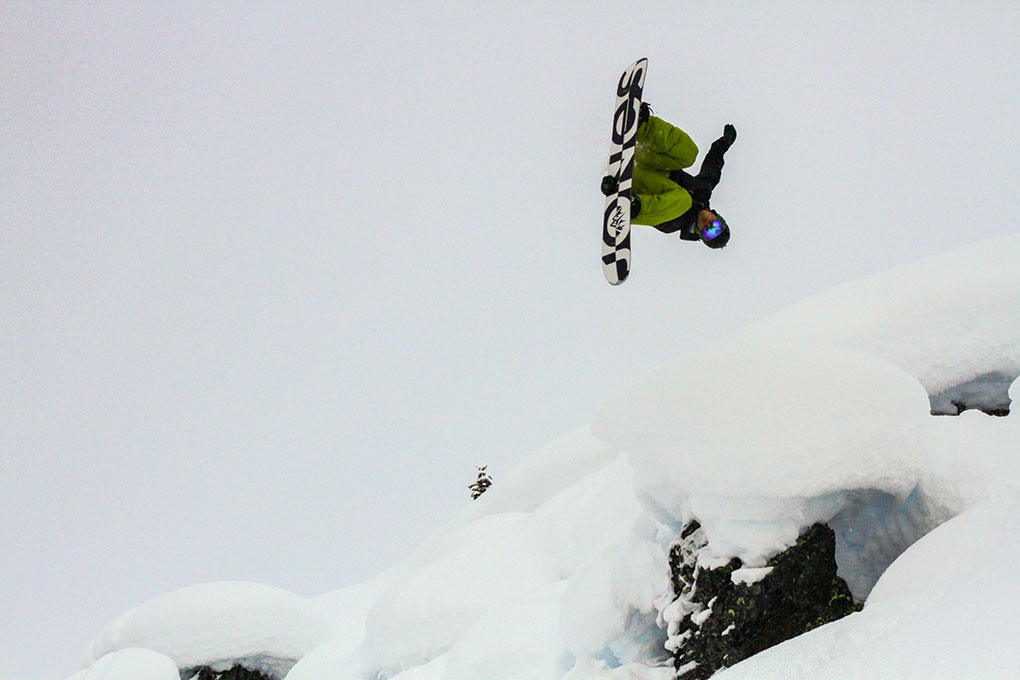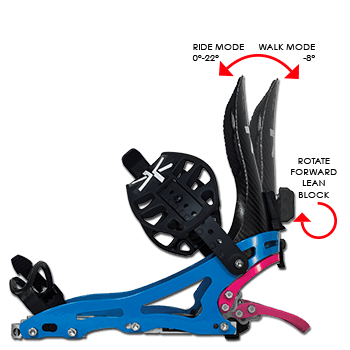
Karakoram Prime Carbon Splitboard Binding
Stated Features:
- Biaxial weave carbon fiber highback
- CNC-machined baseplate with 7075-T6 alloy heelcup
- Solid-Ride 4-point attachment (-30°to 30° stance)
- Power Link locking lever (from touring to ride mode)
- Ride-Stride forward lean (Ride and Walk modes)
- Flip-Speed Riser (two-height riser) with heel lock (DIN 6 equivalent)
- Air-Form ankle strap + Air toe strap
- Includes interface and attachment parts, as well as mounting hardware (Karakoram board clips recommended)
Stated Weight per Binding: 675 grams (size medium)
Blister’s Measured Weight:
- Bindings: 788 & 784 grams (size Medium with Air Form Toe strap and Flex-lock)
- Board Interface: 681 grams
MSRP: $879.99
Boards Used: 161 cm Jones Solution & 161 cm Jones Carbon Solution
Boots: Deeluxe Independent BC Boot
Test Locations: Thompson Pass backcountry & Turnagain Pass backcountry, Chugach Mountains; Hatcher Pass backcountry, Talkeetna Mountains, Alaska
Days Tested: 65
Introduction
The Karakoram Prime Carbon binding is marketed as one of the most refined and technically advanced splitboard bindings available. They boast a series of features that reflect years of testing and development to accommodate a wide variety of riding styles and terrain. The Prime Carbon is the pinnacle of the Karakoram fleet, and is described as the stiffest, lightest, and most responsive binding in their line.

Design / Construction
At first glance, the design of the Prime Carbon intrigued me. The binding’s rigidity and stiffness is said to be achieved by a stronger heel cup, made of 7075-T6 aluminum, which is two times stronger than the material used in other Karakoram bindings.
In addition, the bindings feature titanium pins that are claimed to shave half the weight and be over three times as strong as traditional pins.
The Prime Carbon utilizes a locking mechanism called the Power Link. This lever allows the binding to be removed from or attached to the board interface. The metal lever, located along the bottom of the heel baseplate, engages 2 pins when levered upwards. These pins lock into the heel of the board interface in ride mode, translating to quicker and easier transitioning.

I have not had any issues with the Power Link lever, but I do have concerns about the mechanics and the abundance of moving parts. Should a problem arise, it would most likely occur in a snowpack that transitions from wet, saturated snow to icing/freezing temperatures with elevation, as is often the case with the near sea-level, maritime snowpack of the Chugach Mountains in Alaska.
Air-Form Straps
The Prime Carbon features an Air-Form ankle strap that is made of a semi-elastic Dupont Hytrel rubber, and it has proven to be one of the most comfortable yet secure straps I have used—while remaining 30% lighter than standard straps, according to Karakoram.
The Air toe strap is marketed as the lightest toe strap ever, but it does sacrifice some performance for weight reduction. The toe strap lacks a ratcheting buckle, and instead features a hook-locking mechanism similar to Voile ski straps.
I was unsatisfied with the feel and pressure delivered, and so opted to buy the Air-Form toe strap, a slightly heavier yet still minimal toe strap featuring a traditional ratchet. I now keep the Air strap in my pack as an extremely lightweight backup, although I have had no issues nor complaints with either the Air-Form toe or ankle strap.
Touring
The initial touring performance of the Prime Carbons was unlike any binding I have used. It was immediately evident that side-to-side edging was much more stable and responsive than Spark R&D’s Tesla or LT pin system.
To compensate for the unique shape of the splitboard (straight sidecut on the outer edge) in ski mode, a very stiff and responsive binding with wide contact points is ideal. All other splitboard bindings I have tried have failed to perform well skinning on ice and hardpack, especially when sidehilling. The Prime Carbon’s wide toe brackets seem to compensate for any side-to-side play in the sleeved axles, located along the toe of the binding’s baseplate.

Karakoram has further addressed edging issues with the introduction of the Flex-lock system. The Flex-lock essentially provides lateral support to prevent the ankle from rolling over, maximizing the power transfer to the ski edge.
Activation of the Flex-lock is accomplished by flipping a switch on the top of the highback, which applies additional lateral support through increased tension with the highback.
Karakoram says that the edge-to-edge performance with the Flex-lock engaged is similar to touring with a hard AT boot. While I normally do not use the Flex-lock on most days, I have found it to be very useful, especially when touring with a heavy backpack on ice or hardpack.
The Ride-Stride system is one of the most useful features of this binding while touring. With a quarter turn of the forward lean block (see photo), the highback goes from a forward lean of 22 degrees to a much slacker -8 degrees. This allows for a longer, more efficient, and comfortable touring stride

The heel risers have two heights, and although the riser can initially be hard to engage if it is iced up, they transition from the low to high setting very easily and efficiently.
The risers feature an optional heel locking mechanism that is activated by locking the Power Link lever. When the heel lock is engaged, metal tabs in the Flip Speed riser connect the board to the heel of the binding. The metal tabs are designed to deform before the binding, your knee, or the board is damaged (Karakoram says this deformation will occur at about a release value of DIN 6). It seems likely that a good fall will bend the tabs, which would render the heel lock useless.
Because the heel risers have proven to be one of the more problematic features, I prefer the more dependable wire lifts utilized by the Spark or Voile systems. I’ll go into these issues further in the “Durability” section below.
Overall, excluding the risers, the touring performance of the Karakorams is phenomenal.
NEXT: Transition / Board Interface, Riding, Etc.
